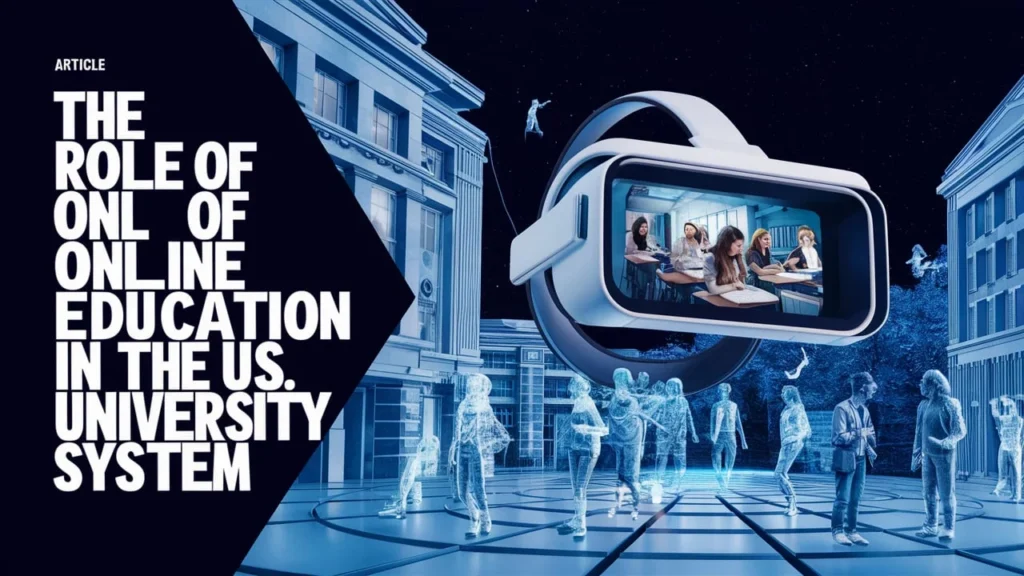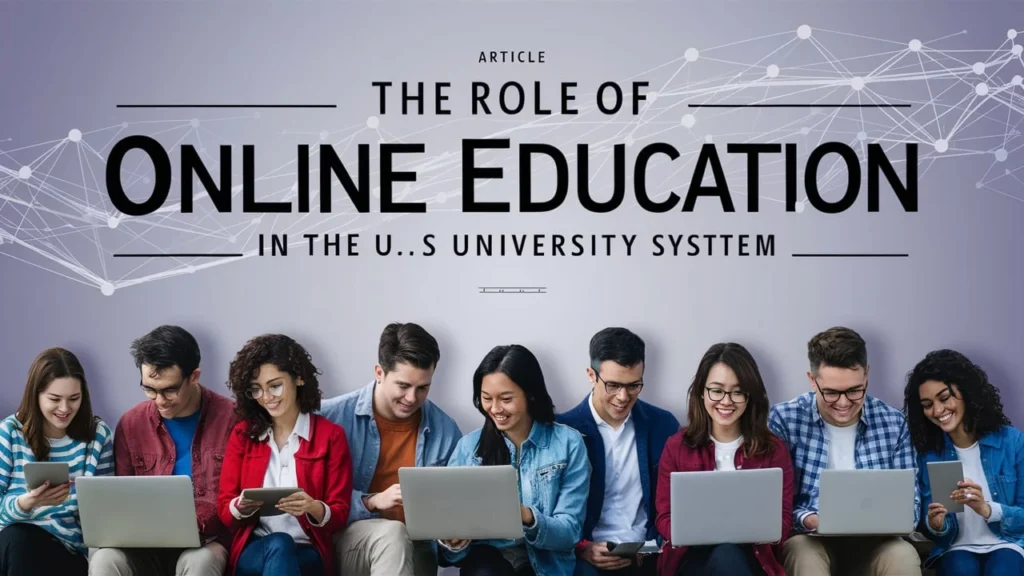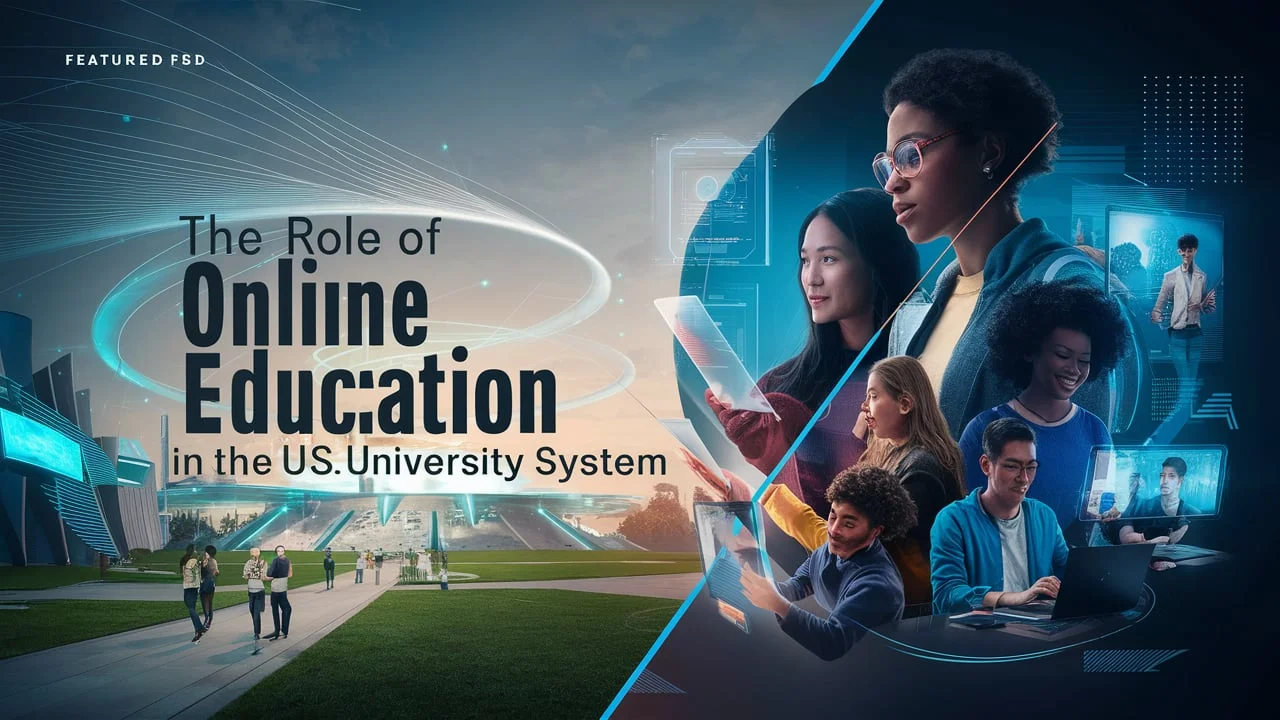Introduction
- Overview of the growing importance of online education in US universities.
- Why universities are expanding online programs (flexibility, accessibility, cost reduction).
- Current statistics on online learning in higher education (percentage of students enrolled, growth trends).
- Purpose of this article: To analyze the impact of online education on students, universities, and the job market.
Evolution of Online Education in the US University System
- Early online education (1990s-2000s) – Correspondence courses & early digital learning.
- Expansion with technology (2010s) – Growth of MOOCs (Massive Open Online Courses), hybrid learning.
- Post-pandemic shift (2020-Present) – COVID-19 as a catalyst for mainstream online education adoption.
- Current state: Over 7 million students enrolled in at least one online course in US universities.
Types of Online Education Models in US Universities
- Fully Online Degree Programs – 100% remote, no campus requirement.
- Hybrid (Blended) Learning – Combination of in-person and online coursework.
- MOOCs (Massive Open Online Courses) – Open access, often free or low-cost.
- Competency-Based Education (CBE) – Students progress based on mastery, not time spent.
- Synchronous vs. Asynchronous Learning
- Synchronous: Live lectures, real-time discussions.
- Asynchronous: Pre-recorded lectures, self-paced assignments.
Advantages of Online Education in US Universities
For Students
Flexibility – Learn from anywhere, ideal for working professionals & parents.
Cost Savings – Lower tuition, no commuting or housing costs.
Diverse Course Offerings – Access to top universities without relocation.
Faster Degree Completion – Accelerated programs allow for quicker graduation.
For Universities
Scalability – More students without increasing physical campus size.
Increased Revenue – Expanding online programs = higher enrollments.
Global Reach – Attracting international students without visa restrictions.
Innovative Learning Methods – AI-driven adaptive learning, virtual labs, simulations.
Example: Arizona State University expanded online programs by 300% in five years, increasing overall enrollment and revenue significantly.
Challenges & Limitations of Online Education
For Students
Limited Hands-On Experience – Labs, medical training, and arts programs are hard to replicate online.
Self-Discipline Required – Online students must be highly motivated.
Perception Issues – Some employers still favor traditional degrees.
Digital Divide – Not all students have reliable internet & technology.
For Universities
High Setup Costs – Developing quality online courses requires large investments.
Academic Integrity Issues – More difficult to prevent cheating & plagiarism.
Faculty Resistance – Some professors prefer traditional teaching methods.
Case Study: Harvard University’s online extension school faced challenges in verifying student identities for exams, leading to stricter proctoring measures.
Comparing Online vs. Traditional University Education
| Factor | Online Education | Traditional Education |
| Flexibility | High – Self-paced or scheduled | Low – Fixed class schedules |
| Cost | Lower tuition, no housing/transport | Higher tuition, on-campus costs |
| Interaction | Virtual discussions, video calls | Face-to-face networking |
| Practical Learning | Limited for lab-heavy fields | Full access to labs & equipment |
| Job Market Perception | Improving but still varies by industry | Generally preferred for some fields |
Example: Online MBA programs from top universities (e.g., Indiana University, University of North Carolina) now compete with traditional MBAs in employer recognition.
The Impact of Online Education on Career Opportunities
- Growing Acceptance by Employers
- 80% of employers now accept online degrees from accredited universities.
- Major companies (Google, Amazon, IBM) now offer jobs to MOOC & online degree graduates.
- Best Fields for Online Degrees
Business & Management
Computer Science & IT
Healthcare Administration
Education & Teaching
Data Science & AI
Case Study: Coursera’s partnership with Google offers an IT support certification that leads directly to job placements at Google.
Accreditation & Quality Assurance in Online Education
- Regional Accreditation – Ensures online degrees meet the same standards as on-campus degrees.
- Well-Known Accredited Online Universities:
- University of Florida Online
- Purdue University Global
- Arizona State University Online
- University of Illinois iMBA
Tip: Always check accreditation before enrolling in an online program to avoid diploma mills.
Future of Online Education in US Universities
Growth Trends
- Online education is expected to grow by 12% annually over the next decade.
- Universities will continue investing in AI-driven adaptive learning.
Technological Innovations
- Virtual Reality (VR) for interactive learning.
- AI-driven personalized learning paths.
- Blockchain for secure degree verification.
Example: Stanford University is experimenting with AI-driven tutoring to customize student learning experiences.
Final Thoughts & Key Takeaways
Online education is now a core part of US universities, offering flexibility and accessibility.
Certain fields, like tech and business, have fully embraced online degrees.
Challenges remain, including academic integrity and limited hands-on training.
The future includes AI-driven learning, VR simulations, and blockchain certification.
Final Tip: For students considering online education, choosing an accredited program from a reputable university is the key to ensuring career success.
The Role of Online Education in the US University System
Introduction
Online education has transformed higher education in the United States. Over the last decade, universities have rapidly expanded online degree programs, hybrid learning models, and digital course offerings. Today, more students than ever are earning degrees without setting foot on campus.
But is online education as effective as traditional learning? How does it impact students, universities, and employers?
In this article, we’ll explore:
The evolution of online education in the US university system.
The benefits and challenges of digital learning.
How employers view online degrees.
The future of higher education in a digital world.
Whether you’re a student, educator, or employer, understanding the role of online education is key to navigating the modern university system.
Evolution of Online Education in the US University System
The Early Years (1990s – 2000s)
The concept of online learning began with distance education in the 1990s. Early courses were delivered through CDs, email, and basic websites.
Example: The University of Phoenix pioneered online degree programs in the late 1990s, making higher education accessible to working adults.
The Expansion of Digital Learning (2010s – 2020)
By the 2010s, online education exploded, thanks to faster internet speeds, learning management systems (LMS), and video-based courses.
Key developments:
- Introduction of MOOCs (Massive Open Online Courses) from platforms like Coursera and edX.
- Ivy League schools like Harvard and MIT launched free online courses.
- Universities started fully online master’s and bachelor’s degree programs.
Example: Arizona State University’s online division grew from 5,000 to over 60,000 students between 2015 and 2020.
The Pandemic Shift: 2020-Present
COVID-19 forced universities nationwide to go fully online, accelerating the adoption of virtual learning technologies.
Statistics:
- Over 98% of US universities transitioned to online classes in 2020.
- Online student enrollments grew by 30% in 2021 alone.
Case Study: Stanford University moved 90% of its courses online in 2020, demonstrating how even elite institutions adapted to digital education.
Types of Online Education Models in US Universities
Online education is not one-size-fits-all. Different universities offer various digital learning formats based on student needs.
1 Fully Online Degree Programs
100% remote learning – No physical classroom requirements.
Available for undergraduate, master’s, and doctoral degrees.
| University | Popular Online Degrees | Accreditation |
| University of Florida Online | Business, Healthcare, Computer Science | Regionally Accredited |
| Purdue University Global | Cybersecurity, Criminal Justice | Regionally Accredited |
| University of Illinois Online | MBA, Data Science | Top-Ranked Online MBA |
Example: A student in California can earn a business degree from the University of Florida without ever visiting campus.
2 Hybrid (Blended) Learning
Hybrid learning combines in-person classes with online coursework.
Best for:
- Lab-based degrees (nursing, engineering, medical programs).
- Graduate students balancing work and school.
Example: The University of Michigan offers a Hybrid MBA program, where students attend online lectures and visit campus a few weekends per semester.
MOOCs (Massive Open Online Courses)
MOOCs are free or low-cost online courses offered by universities worldwide.
Top MOOC Platforms:
- Coursera (Stanford, Yale, Google certifications)
- edX (Harvard, MIT, Columbia)
- Udacity (Tech-focused courses from industry leaders)
Pros:
Affordable – Many courses are free or under $100.
No admissions process – Open to anyone.
Cons:
No formal degree – Employers may not recognize MOOC certificates.
Example: Google’s IT Support Certification on Coursera leads to jobs at Google, IBM, and Accenture.
Competency-Based Education (CBE)
CBE allows students to progress at their own pace based on mastery of skills rather than time spent in class.
Universities Using CBE:
- Western Governors University (WGU)
- Southern New Hampshire University
- Capella University
Benefits:
Faster graduation for self-motivated students.
Ideal for working professionals looking to advance their careers.
Example: At WGU, students complete coursework as fast as they can, allowing them to earn a degree in 2 years instead of 4.
Synchronous vs. Asynchronous Learning
Online programs use two primary learning formats:
| Format | How It Works | Best For |
| Synchronous | Live lectures & real-time interaction | Students who prefer structured schedules |
| Asynchronous | Pre-recorded lectures, self-paced | Students who need flexibility |
Example: Harvard Business School Online uses synchronous video discussions, while Coursera courses are asynchronous and self-paced.
Which Online Education Model is Right for You?
Choose a Fully Online Degree if:
You want complete flexibility and don’t need in-person labs.
Choose Hybrid Learning if:
Your program requires hands-on experience (nursing, engineering).
Choose MOOCs if:
You want to learn new skills affordably but don’t need a degree.
Choose CBE if:
You want to graduate quickly based on mastery of subjects.
Tip: Before choosing an online program, check if the university is regionally accredited for better job recognition.
Advantages of Online Education in US Universities

Online education has fundamentally changed higher learning by making it more flexible, accessible, and affordable for students. Here’s how:
Advantages for Students
1. Flexibility & Convenience
- Students can attend classes from anywhere in the world.
- Ideal for working professionals, parents, and military personnel.
- No need to relocate for top-ranked programs.
2. Lower Costs
- Online programs eliminate housing, meal plans, and transportation expenses.
- Tuition for online degrees is often 30-50% cheaper than on-campus options.
| Degree Type | Average On-Campus Tuition | Average Online Tuition |
| MBA | $60,000 – $100,000 | $20,000 – $50,000 |
| Computer Science Master’s | $50,000 – $80,000 | $15,000 – $40,000 |
| Bachelor’s in Business | $40,000 – $70,000 | $10,000 – $35,000 |
3. Faster Degree Completion
- Many online programs offer accelerated learning paths.
- Some students graduate in 2 years instead of 4.
4. Global Networking & Diverse Classrooms
- Online programs attract students worldwide, allowing for cross-cultural discussions.
Example: Harvard Business School Online has students from 100+ countries, expanding global networking opportunities.
Advantages for Universities
Increased Enrollment & Revenue
- Universities can accept more students without increasing classroom space.
- Online enrollment has grown by 32% since 2019.
Scalability & Innovation
- Online learning allows universities to use AI, VR, and interactive simulations.
- Digital education models prepare students for remote jobs in a digital economy.
Example: Georgia Tech’s Online Master’s in Computer Science costs only $7,000, making it one of the most affordable degrees from a top-ranked university.
Challenges & Limitations of Online Education
Despite its benefits, online education comes with challenges for both students and universities.
Challenges for Students
Limited Hands-On Learning
- Certain fields like nursing, engineering, and medical sciences require physical labs and real-world practice.
- Online programs struggle to replicate practical experiences.
Requires Strong Self-Discipline
- No strict schedules = students must be self-motivated.
- Higher dropout rates in online courses (up to 50% in some cases).
Employer Skepticism in Some Fields
- While tech, business, and healthcare fields accept online degrees, some industries still prefer traditional classroom learning.
Example: A 2022 employer survey found that 85% of HR managers value accredited online degrees, but some still prefer traditional MBAs.
Challenges for Universities
High Setup Costs
- Universities must invest in online platforms, digital tools, and faculty training.
- Developing a quality online program can cost millions.
Academic Integrity & Cheating Concerns
- Difficult to monitor exams and prevent plagiarism.
- Some universities now require AI-based proctoring software.
Example: Stanford University uses AI facial recognition to verify online students during exams.
Employer Perception of Online Degrees
One of the biggest concerns about online education is how employers view online degrees compared to traditional ones.
Are Online Degrees Respected by Employers?
Statistics on Employer Perception:
- 85% of employers say online degrees are as credible as traditional degrees (if accredited).
- 95% of hiring managers accept online degrees from reputable universities (Harvard, MIT, ASU, Purdue).
- Industries like tech, business, and healthcare actively hire graduates from online programs.
Example: Google, Amazon, and IBM all accept online degrees from Coursera, edX, and accredited universities.
Fields Where Online Degrees Are Highly Respected
| Industry | Employer Acceptance of Online Degrees |
| Technology (Software Engineering, AI, IT) | Highly Respected |
| Business & Finance (MBA, Accounting, HR) | Highly Respected |
| Healthcare Administration & Nursing | Growing Acceptance |
| Education & Teaching | Respected |
| Law & Medicine | Requires Traditional Schooling |
Tip: Online degrees from regionally accredited universities are more respected than those from for-profit schools.
Comparing Online vs. Traditional University Education
| Factor | Online Education | Traditional Education |
| Flexibility | High – Self-paced or scheduled | Low – Fixed schedules |
| Cost | Lower tuition, no housing costs | Higher tuition, living expenses |
| Interaction | Virtual discussions, video calls | Face-to-face classroom engagement |
| Networking | Global online community | In-person student & faculty connections |
| Job Market Perception | Growing acceptance, but varies by industry | Traditional degrees still preferred in some fields |
Example: Online MBAs from Indiana University and the University of North Carolina are ranked alongside traditional MBAs in employer rankings.
Who Should Choose Online Education?
Best for:
- Working professionals needing flexibility.
- Students who want a degree from a university in another state.
- Those looking for affordable education options.
Not ideal for:
- Medical, law, or engineering students needing hands-on labs.
- Those who struggle with self-discipline.
The Future of Online Education in the US University System

Predicted Growth Trends (2025-2030)
- Online education enrollment is expected to increase by 50%.
- AI-powered personalized learning experiences will become mainstream.
- Universities will expand virtual reality (VR) learning environments.
Example: Harvard and MIT are already using VR-based classrooms to simulate real-world learning experiences.
Final Thoughts & Key Takeaways
Online education is now a major part of the US university system.
Employers increasingly accept online degrees, especially in business and tech fields.
Online learning provides affordability and flexibility but requires self-discipline.
The future of online education includes AI-driven learning and VR-based courses.
Final Tip: Students considering online education should choose regionally accredited universities for better career prospects.
FAQs About Online Education in US Universities
Are online degrees respected by employers?
Yes, if they come from accredited institutions like Purdue, ASU, and Harvard Extension.
Do online students receive the same diploma as on-campus students?
Yes, most universities do not distinguish between online and traditional degrees.
How much does an online degree cost?
Typically 30-50% less than traditional programs.
What industries accept online degrees the most?
Technology, business, education, and healthcare administration.
Do online students get financial aid?
Yes! Online students qualify for federal student loans, grants, and scholarships.
